Ten One Math Blog
Alien Math Lessons
At Ten One Math, we asked ourselves a fun and important question…
How Would An Alien Race Improve On Human Math?
Just for fun, we wanted to explore the idea of how aliens might look at the math we’re doing here on planet earth. Please enjoy this entertaining article!
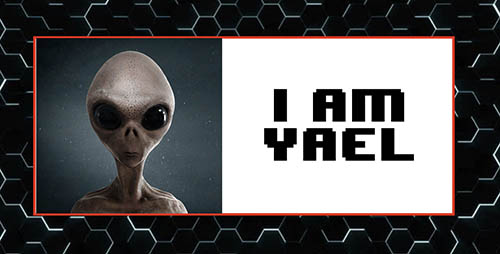
A friendly alien named Yael loves to study human behavior. But humanity is threatened by carbon emissions, no back up planet, and bad math. Yael uses an alien device called a compassion emitter to learn more about humanity's biggest obstacle.

Yael's compassion emitter
Today, 80% of humanity is doing math wrong. By fixing irregular English language number words, humans could solve a problem that threatens humanity's ability to solve all other problems.
What's going on with human math?
Humanity's greatest superpower is worldwide use of base 10 numbers like 1, 24, 5000. Using the same numbers in every nation allows engineers aka STEM graduates to collaborate on tech innovation and existential problems. Unfortunately, the U.S. uses irregular English language number words and therefore produces only 1/2 STEM graduates per capita compared to countries like China.
U.S. - 4 million children born per year / 570,000 = 14% STEM graduates.
China - 16 million children born per year / 4.7 million = 29% STEM graduates.
Based on this data:
U.S. will add another 600,000 STEM graduates per year by teaching young children regular English number words.
First principles approach to number systems
Making a number system isn't something humans do every day. It's not like you wake up, make a new number system, then go to Starbucks.Fortunately, we can learn a lot about this from a friendly alien named Yael.
Today, Yael wants to create a base 4 number system that goes 1-100. Let's see how she uses alien logic.

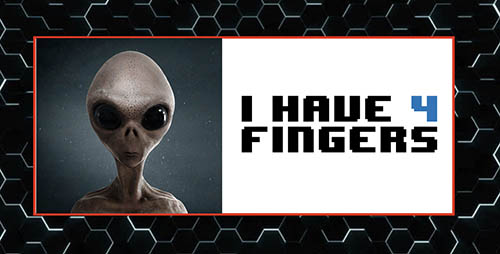
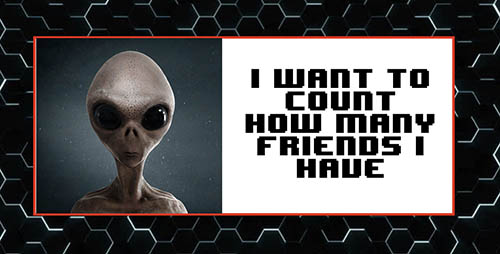
Yael has 4 fingers. She wants to count her friends. She creates 3 unique numbers, like this: 1, 2, 3. Aaaaand don't forget 0 (zero). 0 is required to make a number system from 1 to 100.
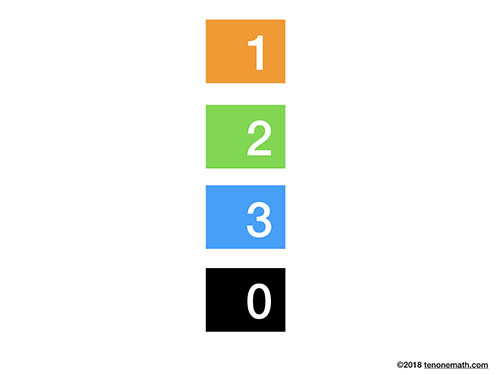
What is 0 good for? 0 unlocks new number columns so you can count higher.
In this case, 0 unlocks the tens column.
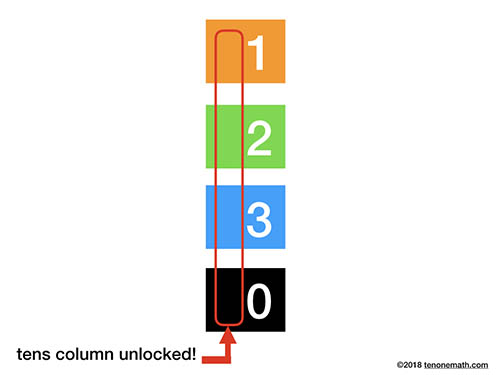
Our friend Yael has 2 fingers on each hand -- 4 in total. In Yael's number system, like in ours, the number 10 will represent her total number of fingers.
So her number system will not go: 1, 2, 3, 4. Instead it will go: 1, 2, 3, 10.
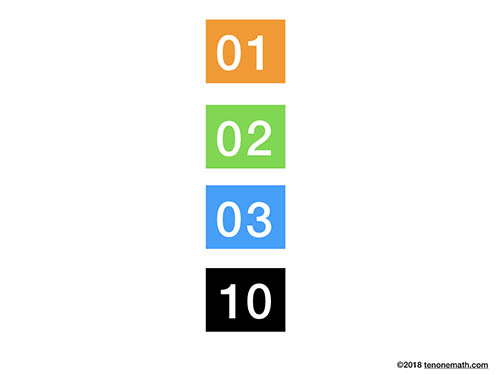
For clarity, we put 0 in the tens place of 1, 2, 3
Now 1-10 is done.
FAQ #1:
Whoa. Time out. Did we skip some numbers? Since when is 3 followed by 10?
Don't worry if you're a little confused here. In base 4, the number that appears after 1, 2, 3... is not 4, but 10. The number 10 in base 4 has the same value as number 4 in base 10.
Whoa. Time out. Did we skip some numbers? Since when is 3 followed by 10?
Don't worry if you're a little confused here. In base 4, the number that appears after 1, 2, 3... is not 4, but 10. The number 10 in base 4 has the same value as number 4 in base 10.
FAQ #2:
Hmm. Shouldn't we use 4 somewhere? Maybe like this: 1, 2, 3, 40?
Only 3 unique numbers are needed to create a base 4 number system. Every other number can be a combination of 1, 2, 3 and 0. So number 4 won't appear in our base 4 number system at all.
Hmm. Shouldn't we use 4 somewhere? Maybe like this: 1, 2, 3, 40?
Only 3 unique numbers are needed to create a base 4 number system. Every other number can be a combination of 1, 2, 3 and 0. So number 4 won't appear in our base 4 number system at all.
Now, what will the next column of numbers look like? In the tens column, all numbers are increased by 1 ten. So we just add 1 to each number in the tens column.
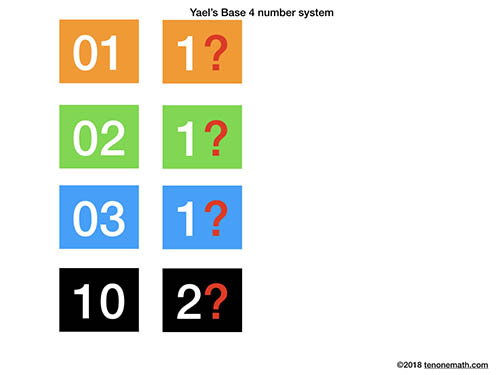
What numbers go in the ones position? Simply copy from the previous column.

Our new numbers are: 11, 12, 13, 20.
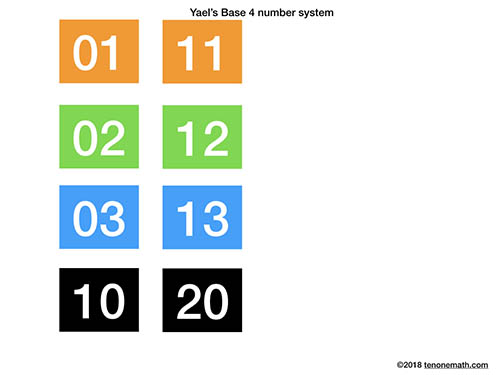
We can apply the same logic to the remaining number columns. Since our number system goes from 1-100, we already know the last number is 100.
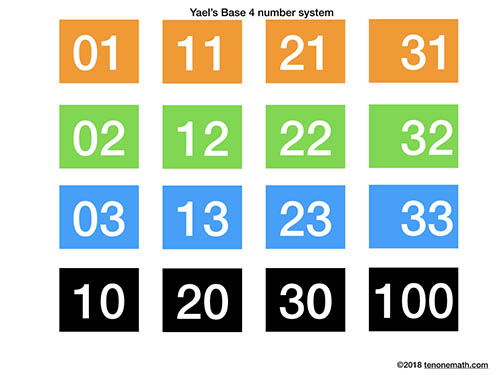
Nice!
Yael's final base 4 number system is an elegant way to count 1-100. There are only 3 unique numbers 1, 2, 3. Plus the special number 0.
By the way, one of Yael's hobbies is reading famous human literature. Not like stories or novels -- Yael's favorite authors are software engineers who write reusable computer code. Elegant, efficient, reusable code makes systems more simple. Yael likes that. As the saying goes: 'Think twice, code once.'
Yael loves humans and she is very perplexed. How is that humans can write logical code, yet 80% of humanity is using an illogical base 10 number system to teach young children? What a terrible oversight. What a terrible price to pay...
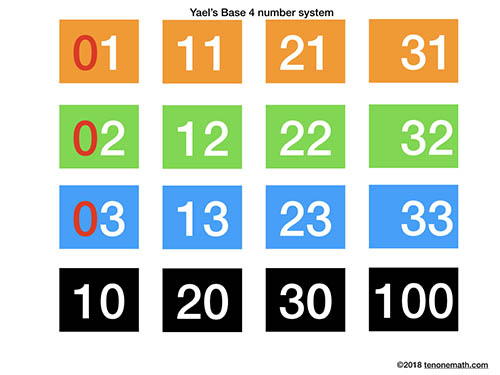
In the left column, we don't need 0 in the tens place. So we will erase those.
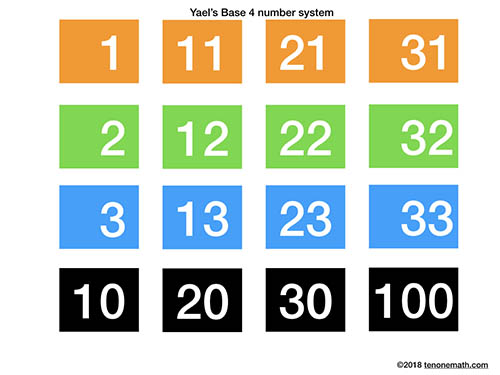
But something's missing. Young children will learn numbers by verbal communication. So Yael must invent number words.
What is a number word?
A number word is a word used to communicate a number by speaking, like 'one', 'two', 'three'.
Just to clarify, we don't say 1. 1 isn't a word, it's a number. Instead, we say 'one'. The word one is a number word.
Before they can read, young children learn by listening. Parents cherish the first words of young children: mama, dada, and number words like one, two, three.
Our alien friend Yael is thinking a lot about number words. Yael knows the full importance of number words is in how easy they make it to teach numbers to young children.
1500 years after humans got numbers right
For the past 1500 years, you could show a math quiz result to a person from India, France, Japan, Russia, or Brazil, and they could check to see if you got it right. By comparing math skills testing results, we can find out which system is most effective for young math learners.Who is at the top of math education?
Without exception, countries who use regular number words rank at the top of world math education.
Alien compassion for young math learners
Using her alien compassion emitter, Yael will design number words so that young children can master 1-100 easily. Must be: logical, consistent, and must clearly communicate place value. Must not be: confusing, difficult to learn.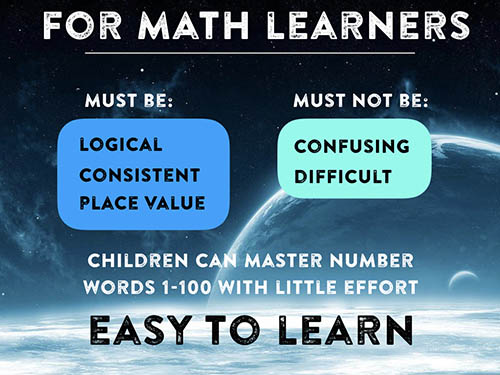
Adults use number words to talk about things like: gas prices, number of friends, and spawn rate. If you take number words away, adults can get along fine with written numbers only.
If adults don't need number words, can't we just get rid of them?
Nooooooo!!!
Number words are critical to humanity because we use number words to teach young children the number system.
Two choices for young children learning math in English:
Yael wants to shine her compassion emitter on planet Earth, so adults will feel good about teaching regular number words to young children. The way Yael sees it, there are two choices:All children on Earth could learn Chinese number words.
Or, somebody with a massive Twitter following could help to promote a system of regular English language number words.
Either way is ok. But we just have to pick one.
1 is one, 2 is two, 3 is three, 10 is ten.
So far, it's exactly like our human base 10 number system.

On to the next column. Just as we re-use our numbers, we can re-use our number words. Like this:
11 is ten one, 12 is ten two, 13 is ten three, 20 is two ten.
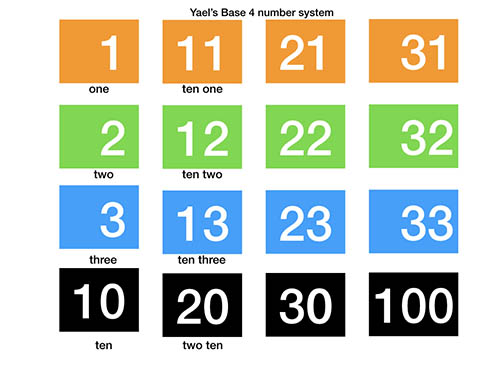
The same logic will apply to the remaining columns:
21 is two ten one, 22 is two ten two, 23 is two ten three, 30 is three ten.
31 is three ten one, 32 is three ten two, 33 is three ten three, 100 is one hundred.
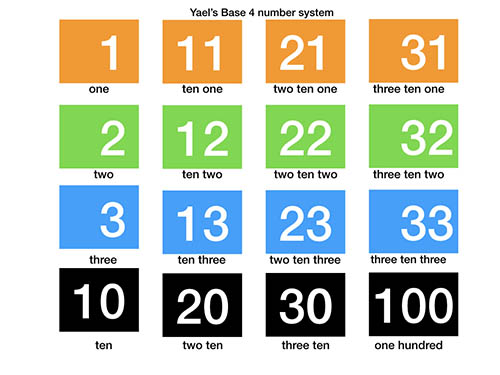
Built from first principles, a base 4 number system only needs 3 unique numbers and number words -- plus 0 and the number word equivalent i.e. ten and hundred.
As you can see, unique numbers and number words appear only in the left column, above 10.
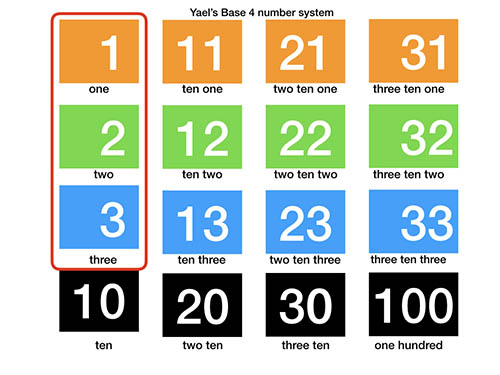
Adding any more unique numbers or number words would create confusion and irregularity which is bad for young math learners.
What it feels like
If we turn off our compassion emitters and remove our intelligence hats, there nothing to stop us from adding irregular numbers to an otherwise logical number system. For numbers greater than 10, we will write <. 20 is >. And 30 is ^. What would this do for our number system?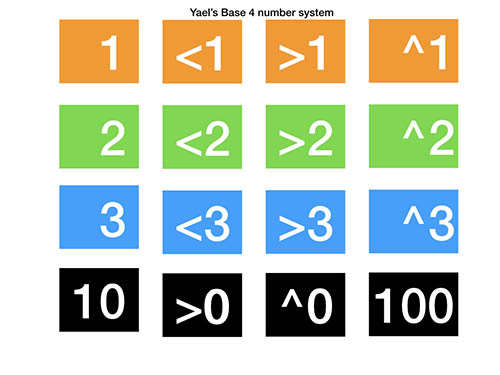
Irregular numbers. Don't try this at home.
Confusion for math learners, with no upside. This is strikingly similar to what we're doing today in U.S. math education. Instead of irregular numbers as above, we are using irregular number words. We can do better, America.
Now let's take a fresh look at the base 10 number system used by humans on planet Earth.
As we've learned, we only need 9 unique numbers and number words.
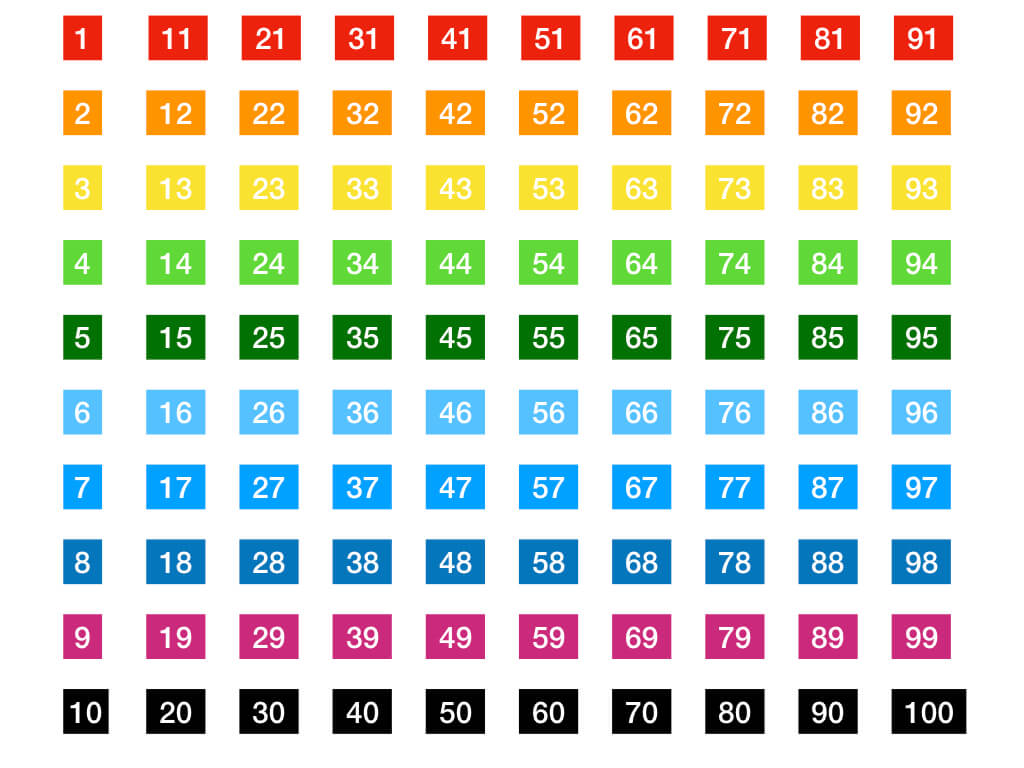
So far so good. There are 9 unique numbers, re-used efficiently. All numbers 1-100 clearly and consistently communicate place value.
How about the number words? Some are ok, like 1-10 and 100. But the rest are irregular.
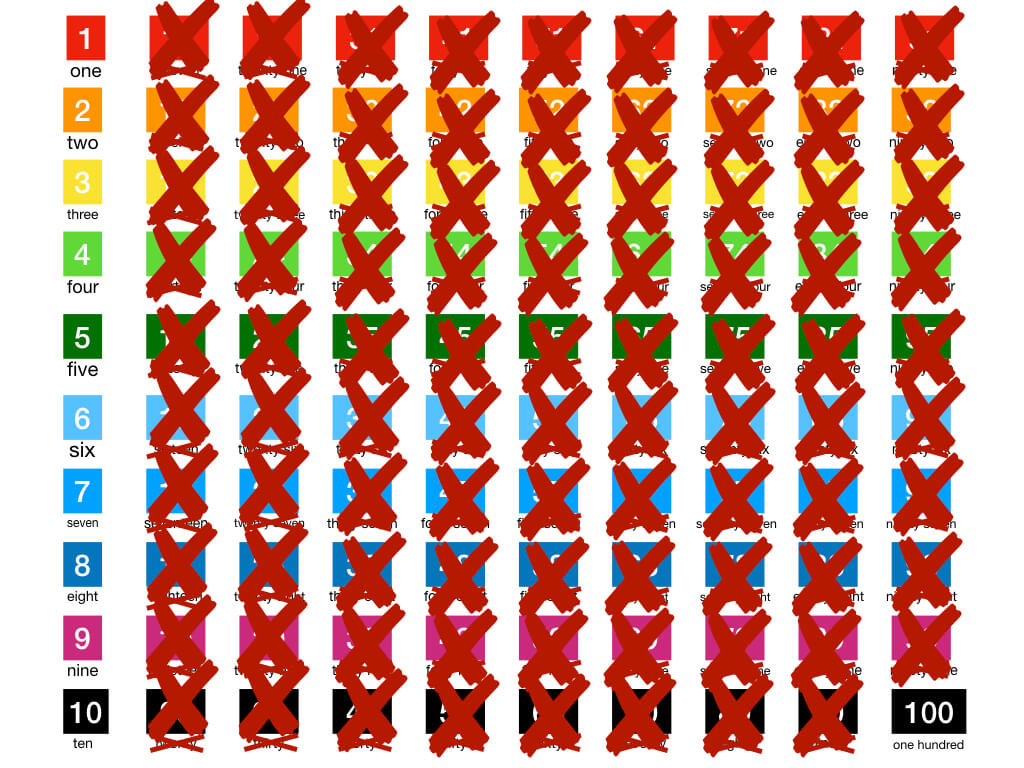
Let's start by fixing up the 2nd column of number words. What number words should we use based on a first principles approach?
11 is ten one. 12 is ten two. 13 is ten three. 14 is ten four. 15 is ten five. 16 is ten six. 17 is ten sev. 18 is ten eight. 19 is ten nine. 20 is two ten.
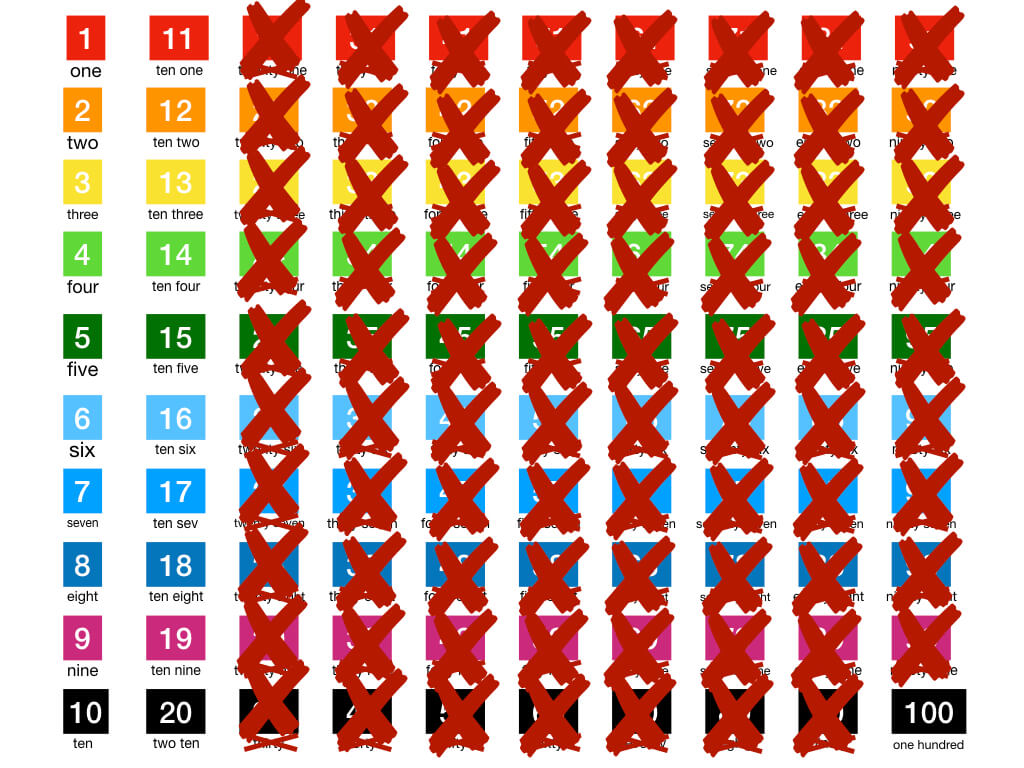
Much improved. Now moving on to the 3rd column.
21 is two ten one. 22 is two ten two. 23 is two ten three. 24 is two ten four. 25 is two ten five. 26 is two ten six. 27 is two ten sev. 28 is two ten eight. 29 is two ten nine. 30 is two ten.
This is what the final number system should look like in base 10. Yael is thrilled. Her compassion emitter is shining rainbow colors of joy for the children of earth.
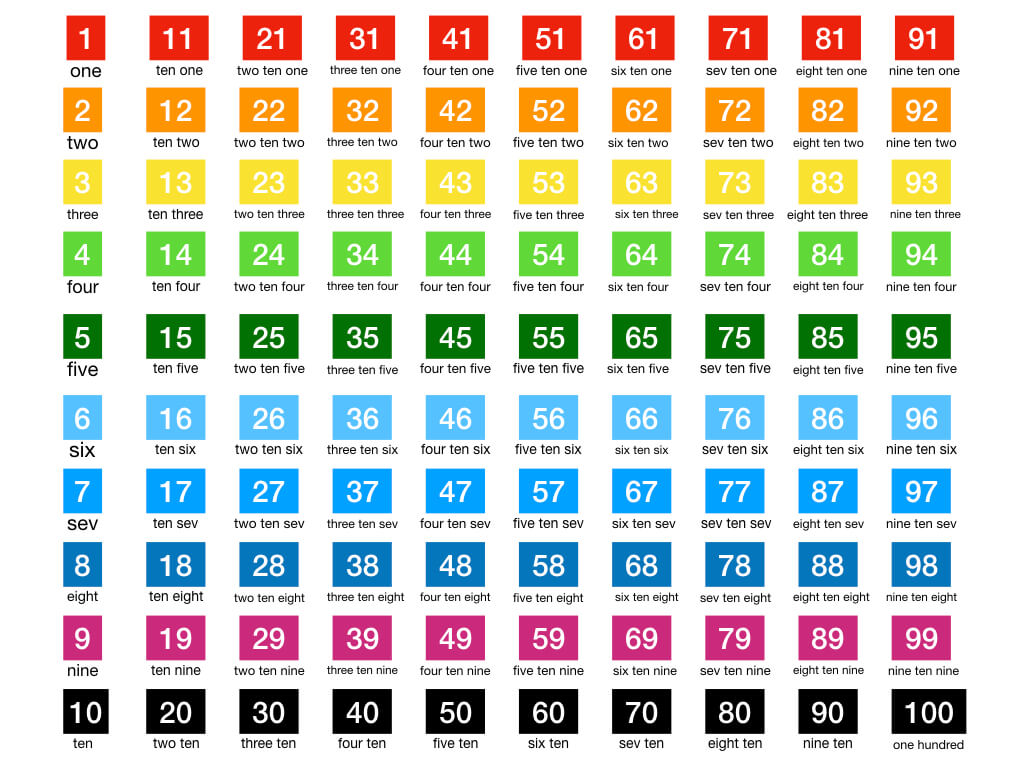
Ten One math promotes the math of the future, today. TenOneMath.com provides free printables, online math games, 1-on-1 Skype coaching sessions to help young children, parents and teachers. Ten One Math depends on the generosity of patrons to keep going because everything we do is free. If you like and if you can, please support Ten One Math.